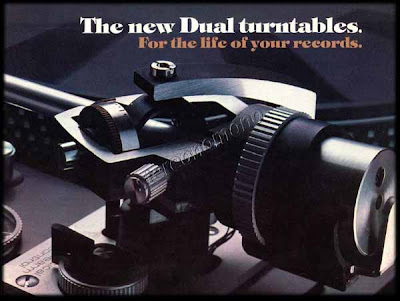
Function and
regulation:
Operation in
single and multi play mode
Balancing of
the tonearm
Setting of
the stylus pressure
Anti-skating mechanism
Cue control
shock-free
Pitch
control and calibration of Pitch control
This is our
lowest-priced turntable, yet we confidently invite you to compare it with
anyone else's highest-priced turntable. Your're not likely to find a tonearm
that seriously matches the CS1237's with its four-point gyroscopic gimbal
suspension and all th eother design features with other Dual tonearms.
You might,
in fact compare the CS1237 tonearm with one of the more exotic separates.
You'll find they cost as much as the entire CS1237
Among the
CS1237's many features are the folowing:
The cueing
system is damped in both directions to prevent bounce.
Pitch control is variable over a 6 percent range.
The strobe
platter is die-cast aluminum and machine-balanced.
Vertical-bearing
friction is astonishingly low-less than 8 milligrams. it can track as low as
0,25 gram - which means it will allow any cartridge to operate at its own
optimum tracking force.
And if you
compare the CS1237 with the higher-priced Dual turntables you'll find they have
additional refinements, but no difference in design integrity or manufacturing
quality.

The CS
1237's tonearm is mounted in a four-point gyroscopic gimbal-widely acknowledged
as the finest suspension system available. The tonearm is centred, balanced and
pivoted exactly where the vertical and horizontal axes intersect.
From pivot
to tonearm head, the shape is a straight line, the shortest distance between
those two important points. Curved tonearms may look sexier, but at the cost of
extra mass, less rigidity and lateral imbalance - none of which is consistent
with good engineering practice.
Tracking
force is applied by a flat-wound spring coiled around the vertical pivot, and
this force is maintained equally on each groov wall whether or not the
turntable is level. The tonearms's perfect balance is maintained throughout
play.
By contrast,
tonearms which apply tracking force by shifting the counterweight forward are
actually unbalanced during play and prone to mistracking. For example, on
warped records the stylus tends to dig in on the uphill side of the warp and to
lose contact on the way down.
Vertical-bearing
friction in the CS 1237 tonearm is astonishingly low - less than 8 milligrams.
It can track as low as 0,25 gram - which means it will allow any cartridge to
operate at its own optimum tracking force.
There's still more. The counterweight is carefully
damped to attenuate tonearm resonances. Anti-skating is separately calibrated
for all stylus types. Cueing is damped in both directions to prevent bounce.
And because the CS 1237 can play up to six records in sequence, the stylus
angle can be set for optimum vertical tracking in either single-play or
multiple-play.
To find any
other tonearm that seriously matches the CS 1237's, you have two choice.
You can
consider one of the more exotic separates. But you'll find they cost as much as
the entire CS 1237 (price: less than $180, complete with base and cover)
Or you might
compare it with one ofthe higher-priced Dual turntables. You'll find a few
additional refinements, but no difference in design integrity or manufacturing
quality. Which is why no other turntable quite matches a Dual , any Dual

all Dual
tonearms are mounted in this four-point gyroscopic gimbal. Tonearm mass
iscentered and pivots precisely where the vertical and horizontal axec
intersect
Straight-line
tubular shape of all Dual tonearms provides maximum rigidity with low mass.
Offset angle of tonearm head achieves lowest angle of tonearm head achieves
lowest possible horizontal tracking error. Curved lonearms with the same
effective lengh require more mass

Technical
data
Drive: Dual 8-pole synchronus motor with precision
flat beltfor flywheel drive
Power
Consumption: ‹ 10 watts
Current
Drain: 64 mA approx. at 220 V, 50
cycle; 115 mA, at 110 V, 60 cycle
Platter: non-magnetic, detachable ; 1,00 kg, 270 mm diameter
Turntable
Speeds: 33⅓ and 45 rpm
Automatic
tonearm set-down coupled to speed adjustment
Pitch
Control Variation: adjustment range of
approx. 1 semitone (6%) at both turntable speeds
Total Wow
and Flutter: less than ±0,10 %
(according to DIN 45 507)
Rumble: unweighted
better than 40 dB, weighted better than
60 dB
Tonearm: Torsion-resistent tubular aluminium tonearm
in four point gimbal
Tonearm
Bearing Friction: (related to stylus
tip)
Vertical
: less than 0,08mN (0,008 g)
Horizontal
: less than 0,16 mN (0,016 g)
Cartridge
Holder: removable, accepting any
piezo-electric cartridges with ½"mounting
and a weight from4,5 to 10 grams
(including mounting hardware)
Stylus
Pressure: from 0 - 50 mN (0 -5 g)
infinitely variable, operable from 5 mN (0.5 gram) stylus pressure up.
Adjustable
Overhang: 5 mm
Cartridge: see separate data sheet
Power
Supply: AC, 50 or 60 cycle, changeable
by changing motor pulley
Power Supply
Voltage: 110-125 V or 220-240 V,
switchable
Dimensions:
Chassis:
13 x 10¾ inches;
Base:
16½ x 14½ x 3½ inches;
Height
with cover: 7¼ inches
Weight: approx. 4,6 kg

Nessun commento:
Posta un commento